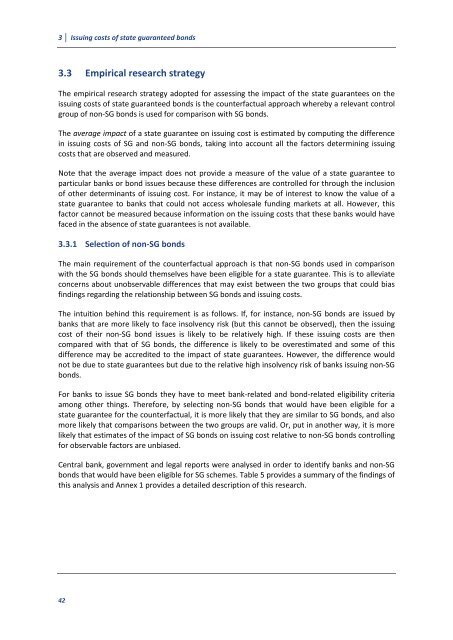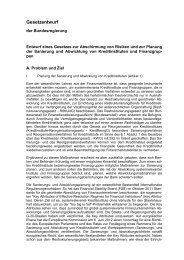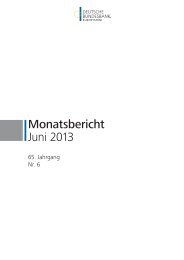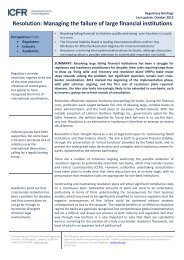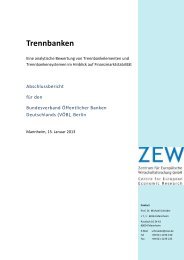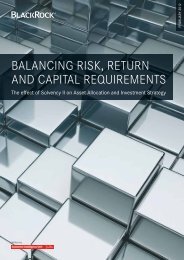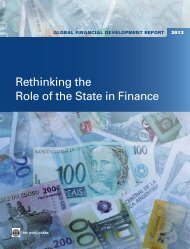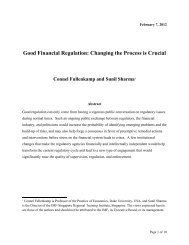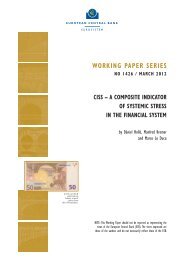3 Issuing costs of state guaranteed bonds - Financial Risk and ...
3 Issuing costs of state guaranteed bonds - Financial Risk and ...
3 Issuing costs of state guaranteed bonds - Financial Risk and ...
You also want an ePaper? Increase the reach of your titles
YUMPU automatically turns print PDFs into web optimized ePapers that Google loves.
3 <strong>Issuing</strong> <strong>costs</strong> <strong>of</strong> <strong>state</strong> <strong>guaranteed</strong> <strong>bonds</strong><br />
3.3 Empirical research strategy<br />
The empirical research strategy adopted for assessing the impact <strong>of</strong> the <strong>state</strong> guarantees on the<br />
issuing <strong>costs</strong> <strong>of</strong> <strong>state</strong> <strong>guaranteed</strong> <strong>bonds</strong> is the counterfactual approach whereby a relevant control<br />
group <strong>of</strong> non-SG <strong>bonds</strong> is used for comparison with SG <strong>bonds</strong>.<br />
The average impact <strong>of</strong> a <strong>state</strong> guarantee on issuing cost is estimated by computing the difference<br />
in issuing <strong>costs</strong> <strong>of</strong> SG <strong>and</strong> non-SG <strong>bonds</strong>, taking into account all the factors determining issuing<br />
<strong>costs</strong> that are observed <strong>and</strong> measured.<br />
Note that the average impact does not provide a measure <strong>of</strong> the value <strong>of</strong> a <strong>state</strong> guarantee to<br />
particular banks or bond issues because these differences are controlled for through the inclusion<br />
<strong>of</strong> other determinants <strong>of</strong> issuing cost. For instance, it may be <strong>of</strong> interest to know the value <strong>of</strong> a<br />
<strong>state</strong> guarantee to banks that could not access wholesale funding markets at all. However, this<br />
factor cannot be measured because information on the issuing <strong>costs</strong> that these banks would have<br />
faced in the absence <strong>of</strong> <strong>state</strong> guarantees is not available.<br />
3.3.1 Selection <strong>of</strong> non-SG <strong>bonds</strong><br />
The main requirement <strong>of</strong> the counterfactual approach is that non-SG <strong>bonds</strong> used in comparison<br />
with the SG <strong>bonds</strong> should themselves have been eligible for a <strong>state</strong> guarantee. This is to alleviate<br />
concerns about unobservable differences that may exist between the two groups that could bias<br />
findings regarding the relationship between SG <strong>bonds</strong> <strong>and</strong> issuing <strong>costs</strong>.<br />
The intuition behind this requirement is as follows. If, for instance, non-SG <strong>bonds</strong> are issued by<br />
banks that are more likely to face insolvency risk (but this cannot be observed), then the issuing<br />
cost <strong>of</strong> their non-SG bond issues is likely to be relatively high. If these issuing <strong>costs</strong> are then<br />
compared with that <strong>of</strong> SG <strong>bonds</strong>, the difference is likely to be overestimated <strong>and</strong> some <strong>of</strong> this<br />
difference may be accredited to the impact <strong>of</strong> <strong>state</strong> guarantees. However, the difference would<br />
not be due to <strong>state</strong> guarantees but due to the relative high insolvency risk <strong>of</strong> banks issuing non-SG<br />
<strong>bonds</strong>.<br />
For banks to issue SG <strong>bonds</strong> they have to meet bank-related <strong>and</strong> bond-related eligibility criteria<br />
among other things. Therefore, by selecting non-SG <strong>bonds</strong> that would have been eligible for a<br />
<strong>state</strong> guarantee for the counterfactual, it is more likely that they are similar to SG <strong>bonds</strong>, <strong>and</strong> also<br />
more likely that comparisons between the two groups are valid. Or, put in another way, it is more<br />
likely that estimates <strong>of</strong> the impact <strong>of</strong> SG <strong>bonds</strong> on issuing cost relative to non-SG <strong>bonds</strong> controlling<br />
for observable factors are unbiased.<br />
Central bank, government <strong>and</strong> legal reports were analysed in order to identify banks <strong>and</strong> non-SG<br />
<strong>bonds</strong> that would have been eligible for SG schemes. Table 5 provides a summary <strong>of</strong> the findings <strong>of</strong><br />
this analysis <strong>and</strong> Annex 1 provides a detailed description <strong>of</strong> this research.<br />
42


